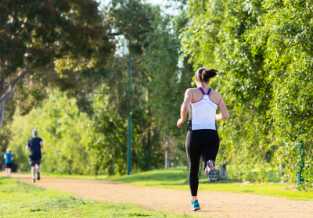Detailed Tips On Your Running Technique
Published on
15 Dec 2014

Call us on: (03) 9975 4133
How many of us really know what we look like when we run? Asks Pure Director and avid runner, Kate Senini. While there are many varied running techniques, some can contribute to injuries, and others are just wasting energy! Here are few tips for each body part that will help you to be a better runner and help to prevent injury:
In October, we discussed whether a change of running technique might be beneficial: https://www.purephysio.com.au/blog/change-technique-running-debate/.
Pure Director and avid runner, Kate Senini is here to provide more detail to help you answer that question! “How many of us really know what we look like when we run?” Asks Kate. Your running technique can influence your efficiency and therefore your speed and endurance, and can also be responsible for a raft of injuries.
Running techniques are varied. Sprinters, for instance, run exclusively on the front of their foot, whereas distance runners will be anything from heel strikers, to forefoot runners (and everything in between!) Sprinters will also use their arms a lot more, which in turn helps drive the acceleration through their legs. Distance runners, however, would be better served reducing their arm swing to conserve energy.
While there are many varied running techniques, some can contribute to injuries, and others are just wasting energy! Here are few tips for each body part that will help you to be a better runner and help to prevent injury:
The Head
The head needs to remain relatively still and should track at a fairly constant height, i.e: not bouncing up and down as you run. If your stride length is too long or you are too upright, you will tend to bounce. Much better to reduce the effect of gravity and go forward rather than up and down! Long bouncy strides are also more likely to result in problems around the outside of your knee – commonly known as runners knee or ITB syndrome.
The Shoulders
The shoulders need to remain relaxed, not fixed backwards and not hunched up towards your ears. Upper back, shoulder blade or neck pain can occur due to tension build up in the muscles around the neck and shoulders, which is directly linked to your running posture.
The Arms
Arm swing is hugely important and influences your speed, stride length, efficiency and more. Your hands shouldn’t swing across your body to the midline, and should always be even in their swing length. If one arm swings further forwards it can rotate your body and even change the amount of weight going through each leg. If you are looking to accelerate, or when running shorter distances, increasing your arm swing should help increase your speed.
The Pelvis
The pelvis should remain relatively level when running and should not tilt too far forwards. Too much forward tilt of the pelvis causes an increased arch in the lower back, tension in the fronts of the hips, and poor glute (buttock) muscle use which can lead to back pain, hip pain, a multitude of lower limb injuries, and hinder optimal performance. Side to side tilting of the pelvis is another sign of poor glute and core control and predisposes you to injuries including back pain, ITB syndrome, Patello-Femoral Knee Pain, and foot injuries (as well as making you a less efficient runner!)
The Feet
Many runners are heel-strikers, that is, their heels are the first point of contact with the ground. There has been much debate in recent years as to which part of the foot is best to land on. However, more recent research suggests that it is not which part of the foot you land on (i.e. heel, midfoot or forefoot), but where the foot lands in relation to your body that matters most.
Landing with the foot directly underneath the body allows the force of striking the ground to be absorbed more effectively throughout the body, as opposed to when the foot strikes out in front. Furthermore, landing with the foot underneath the body improves the momentum of forward propulsion, while landing out in front creates a “braking” effect.
Which part of the foot you land on still has an impact, as it influences which structures in your absorb most of the force. Toe runners, for example, absorb most of the force in their toes and therefore are more prone to problems around the big toe. They also put more strain on their calves, often resulting in calf tightness for this group of runners.
Another important consideration with feet is the degree of pronation (inward rolling) or supination (outward rolling) that takes place as your weight comes onto your foot. Ideally there will be a small amount of pronation as this helps with shock absorption. However, too much pronation, or remaining in pronation for too long, can be a major problem as it affects many structures including your calf muscle, achilles tendon, knee alignment, hip alignment, and spine.
In an ideal world your foot should be in a level position as you push off. This stiffens up the foot, allowing you to push yourself forward without using too much muscular effort and using the big toe as a strong lever.
Stability or motion control shoes, along with orthotics and specific rehabilitation exercises can all be used to correct foot biomechanics and thus prevent injury and improve performance. A thorough biomechanical running assessment is a fantastic way to detect and act appropriately on any specific problem areas.


